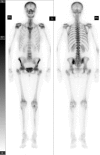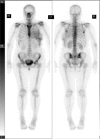Two cases of mimics of bone metastasis in breast cancer
- PMID: 30363150
- PMCID: PMC6159113
- DOI: 10.1259/bjrcr.20170091
Two cases of mimics of bone metastasis in breast cancer
Abstract
In patients with breast cancer, the appearance of sclerotic bone lesions on imaging should raise the suspicion of skeletal metastases. However, before making the diagnosis it is important to consider the clinical context and remember that there are conditions that can mimic bone metastasis. We present two cases of mimics of bone metastasis: systemic mastocytosis and osteopoikilosis. These cases demonstrate clinical and radiological characteristics that would make a diagnosis of bone metastasis less likely, and highlight the need for an awareness of mimics of bone metastasis.
Figures





Similar articles
-
Metastatic breast carcinoma to bone disguised by osteopoikilosis.Skeletal Radiol. 2003 Apr;32(4):240-3. doi: 10.1007/s00256-002-0605-x. Epub 2003 Feb 13. Skeletal Radiol. 2003. PMID: 12652341
-
Osteopoikilosis masquerading as osseous metastases in breast cancer.Breast Cancer. 2014 Nov;21(6):765-8. doi: 10.1007/s12282-011-0300-7. Epub 2011 Oct 12. Breast Cancer. 2014. PMID: 21990037
-
Gastric cancer bone metastases together with osteopoikilosis diagnosed using bone scintigraphy and 18F-FDG PET/CT.Rev Esp Med Nucl Imagen Mol. 2017 May-Jun;36(3):189-193. doi: 10.1016/j.remn.2016.04.010. Epub 2016 Jun 18. Rev Esp Med Nucl Imagen Mol. 2017. PMID: 27329562 English, Spanish.
-
Progeny in an Inhospitable Milieu-Solitary Intraventricular Metastasis From a Triple-Negative Breast Cancer Mimicking Central Neurocytoma: Case Report and Review of Diagnostic Pitfalls and Management Strategies.World Neurosurg. 2020 Mar;135:309-315. doi: 10.1016/j.wneu.2019.12.066. Epub 2019 Dec 19. World Neurosurg. 2020. PMID: 31863888 Review.
-
Breast cancer bone metastases: pathogenesis and therapeutic targets.Int J Biochem Cell Biol. 2018 Mar;96:63-78. doi: 10.1016/j.biocel.2018.01.003. Epub 2018 Jan 5. Int J Biochem Cell Biol. 2018. PMID: 29309917 Review.
References
-
- Pavlakis N, Schmidt R, Stockler M.. Bisphosphonates for breast cancer. Cochrane Database Syst Rev 2005; 20. - PubMed
-
- Andersen CL, Kristensen TK, Severinsen MT, Møller MB, Vestergaard H, Bergmann OJ, et al. . Systemic mastocytosis--a systematic review. Dan Med J 2012; 59: A4397–402. - PubMed
-
- Horny H, Akin C, Metcalfe D. et al. . WHO claddification of tumours of haematopoietic and lymphoid origin : Swedlow SH. . Mastocytosis. Lyon: IARC; 2008. 54–63
-
- Jangir RR, et al. . Osteopoikilosis and its clinical significance: a review of the literature. Research and Reviews. Journal of Medical and Health Sciences, 2014; 3: 11–20.
-
- Metcalfe DD, Baram D, Mekori YA.. Mast cells. Physiol Rev 1997; 77: 1033–79. - PubMed
Publication types
LinkOut - more resources
Full Text Sources

